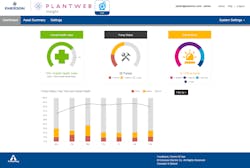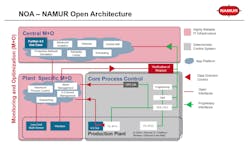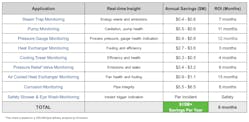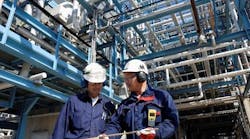Emergence of the industrial internet of things (IIoT) with its promises of digital transformation (DX) is now a key talking point for many companies as management teams strive to improve operations, drive innovation and stay competitive.
But, ambiguity has caused misconceptions about how to actually achieve these benefits by implementing digital solutions. Specifically, the lack of a clear path for executing DX projects has left many companies uncertain about the best ways to get started. For some, this has resulted in a reluctance to deploy digital solutions. For others, it has caused disappointment when projects fail to deliver the expected results.
This article examines seven IIoT and DX myths responsible for much of these issues.
Myth 1: Basic lick-and-stick sensors are the solution to everything
Much of what has come to define IIoT has been adopted from consumer electronics. For example, if you want to save on your heating bill, go to your big-box home store and buy a web-enabled thermostat. If nobody’s in the house, turn the heat down from an app on your smartphone. If the family room tends to be too cold, buy another web-enabled sensor to communicate with your main thermostat via the internet. These applications are all built upon inexpensive and basic plastic devices. Potential benefits are intriguing, but the mere increased availability of sensor technology does not equate to sensor viability — that is, the need for sensors, especially in an industrial environment, to continuously perform in rugged conditions.
Obviously, residential-grade sensors cannot be used to monitor a distillation column or a pump moving high-value product, but manufacturers need to look for viable and economic ways to add measurement points. This can be accomplished by using wireless instruments designed to operate for decades in potentially harsh environments. These measurement points were typically deemed cost prohibitive when implemented using traditional methods but can now be added for a fraction of the cost with wireless and sometimes nonintrusive technology.
Wireless instruments cut the installation cost of vibration, pressure, temperature, flow, level, acoustic and many other sensor types dramatically by eliminating the need for expensive communications and power wiring. Furthermore, these instruments integrate into existing infrastructure or new analytics environments using industry-standard protocols and interfaces.
Users looking for inexpensive sensors need to consider the entire framework of costs associated with adding measurements. This includes reliability, safety, reduction of wiring costs, ease-of-use and installation, while also accounting for total return on investment instead of simply looking for the lowest capital cost.
Myth 2: Machine learning and artificial intelligence (AI) are necessary to identify and solve every problem
Machine learning and AI will transform analytics and how industrial companies do business, but these technologies will not, and should not, be used in every situation. There are still many use-cases that will utilize proven approaches in practice today. These approaches, technologies and practices are improvements over the status quo but are not as costly, time-consuming or complex as machine learning and AI implementations.
More advanced analytics such as machine learning and AI can be part of the program, but they are extensions of familiar and proven techniques, applied more consistently and frequently. These analytic software apps can prompt users to find problems before they affect operations. For example, model-based analytics can make users aware of large fluctuations and trends. These predictive tools help identify abnormal conditions without the need for complex analysis and years of data mining.
Myth 3: Jobs will be eliminated
Throughout the last 20 years, the process manufacturing workforce industry-wide has been thinned due to the advancement of automation and cost-cutting. Now, as many experienced individuals are retiring, finding replacements is a challenge as the population of what would now be mid-career people has been hollowed out. New people, when they can be found and recruited, are typically less experienced and need to be brought up to speed quickly.
Adopting effective DX strategies can improve all facets of this situation. Tedious, low-value-add tasks, such as manual inspection rounds, can be automated. In many situations, those rounds may have fallen by the wayside already. Effective DX means an increase in productivity, not a reduction of plant personnel, as it enables them to spend more time on critical tasks and empowers them to make more effective, data-driven decisions.
At the same time, new employees can get up to speed much quicker and gain valuable skills by using the technologies with which they have become familiar throughout their lives. Millennial workers, often referred to as “digital natives,” will take more naturally to these high-tech solutions, finding concepts of DX second nature. IIoT and DX will provide tools to increase productivity while upskilling the current and new workforce.
Myth 4: Technologies are unproven
While some of the technologies used to support DX are still evolving, most of the core principles, upon which they are based, have been around and in use for decades. There is nothing magical about monitoring the condition of a pump. A technician checking manually will listen for abnormalities, read vibration, etc. Automated monitoring as part of a DX program will do the same things but in a safer, more cost-effective way. Even software analytics models have been used for decades and will continue to go through various improvements as better algorithms evolve to capture and analyze the data.
Even the latest analytical tools build on proven concepts. Continuing with the pump example, a DX program does not change the threshold for the amount of vibration considered problematical. If anything, moving to an automated platform codifies the practice and reduces errors from manual readings. It also expands and improves upon manual practices by examining trends and significant changes in data — a type of analysis not practical with infrequent manual inspection. Analytical tools are purpose-built for those tasks using known solutions for common problems. When the right technology is put in the hands of the right user and matched to a corresponding problem, asset availability improves and costs decline.
Myth 5: Every sensor must be connected directly to the internet
If the internet is part of the larger solution, doesn’t every instrument need to be connected to it? IIoT is all about the internet after all, right? This might seem obvious, but for real-world applications, it is likely unnecessary and overkill. While a few strategic field or edge devices may communicate to data lakes in the cloud, there is usually little need to go to that extreme. The use of on-premise and edge analytics can bring decision-making much closer to the personnel responsible for acting on the situation, while eliminating the need for more complex and all-encompassing solutions.
Myth 6: Digital transformation is strictly top-down and must be implemented all at once
Thinking about the great transitions of automation technology, most were adopted on an incremental basis, or at least could be implemented when upgrading an existing facility. Even plants converting from pneumatic to electronic control could make this change incrementally. Such is the case with DX.
Projects can be launched on a small scale and driven from the plant level where challenges and pains are known by the personnel interacting with the process daily, with the knowledge of operations personnel informing DX projects. Frontline personnel understand what specific challenges need to be addressed to drive performance improvements, bringing valuable perspective to these projects by informing them from the bottom-up.
If pump failures are a routine problem, it is a simple matter to outfit a few of the most troublesome installations with condition monitoring instruments able to communicate via WirelessHART protocol. An analytics app designed for this type of application (see Figure 4) can collect and process the data and then provide recommendations for when repairs need to be made before an outright failure. This approach to DX — a series of small changes combined together to provide big results — takes advantage of the scalability of the technology.
Myth 7: Digital transformation is too expensive with substantial hardware and IT costs
No project is free of costs, but the right projects can either create an income stream or reduce other costs to cover investments. The question becomes: Is the return on investment attractive enough to cover the initial and lifetime costs? Companies considering DX projects sometimes struggle to answer this because they are unsure of the costs and possible returns.
Many small-scale DX projects, such as automated condition monitoring of a specific type of asset, can be implemented with minimal cost in just a few days. If the monitoring instruments are installed on an existing WirelessHART network with sufficient capacity, the work can be done in a single day, with no requirement for new wired infrastructure. The apps to gather and analyze data require very little network overhead and are user-configurable with no custom coding required.
Users who have installed monitoring for basic classes of assets such as steam traps, pressure relief valves and heat exchangers have typically realized full project cost payback in six months to a year (see Figure 5).These types of projects have been deployed in enough locations and have enough common elements to make many of the experiences comparable, allowing users to learn from past deployments and duplicate or improve upon results. After the savings are recognized from the first project, companies are able to use those savings to fund the next improvement opportunity, creating the ability to continuously multiply their successes across their plants and the enterprise.
Conclusion
Some people get hung up on the notion of DX because of the myths they have heard, which often make things seem too complex and expensive. The truth is, IIoT and DX projects do not need to be major undertakings launched all at once by corporate directive.
To put this in more positive terms, think of DX as the collective outcome of a variety of smaller projects aimed at improving plant performance through higher availability and reduced costs. Addressing pain points confronted on a daily basis at the plant level is a much better approach than launching technological and behavioral change by decree. Keep in mind, the technology needs to be accompanied by procedural changes. No actual gains will be realized if the pump monitoring solution put in place indicates a pending failure and nobody acts on the warning.
Proven, easy-to-deploy and scalable monitoring solutions can be used to implement this type of incremental approach to solving problems and improving performance. And, as more of these solutions are implemented, their cumulative effect is an overall improvement in performance across multiple areas that positions a company to maintain its competitive edge in both the near and long term.
References
- Plantweb Insight Applications: https://www.emerson.com/en-us/catalog/ emerson-sku-plantweb-insight-application.
Brian Joe is a wireless product manager for Emerson’s Automation Solutions business in Shakopee, Minnesota, responsible for analytic applications and solutions. He holds a Bachelor of Science in mechanical engineering from Purdue University and a Bachelor of Science in economics from Butler University.







